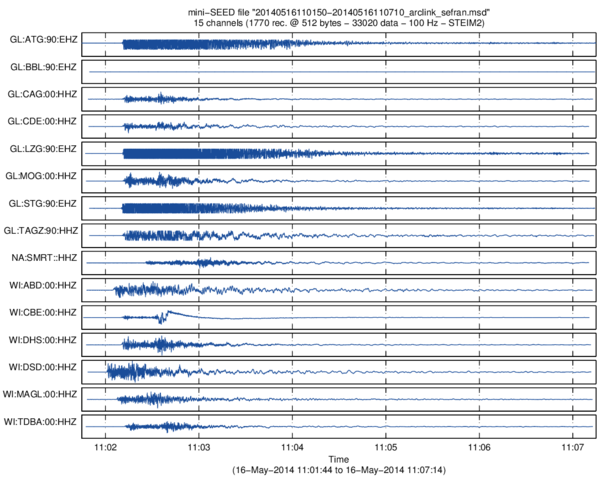The Standard for the Exchange of Earthquake Data (SEED) is an international standard format for the exchange of digital seismological data. SEED was designed for use by the earthquake research community, primarily for the exchange between institutions of unprocessed earth motion data. It is a format for digital data measured at one point in space and at equal intervals of time. The SEED format consists of Volume Control Headers, Abbreviation Control Headers, Station Control Headers, Time Span Control Headers and finally Data Records. In complement to “Dataless” SEED volumes, exists the “Data-only” volume called Mini-SEED (see http://www.iris.edu for further information).
The purpose of these functions is to read and write miniSEED data files directly from Matlab, avoiding intermediate format conversion (like SAC or other formats for which many functions exist), having a full control on headers and formats.
The function has the particularity to be respectful of the SEED standard, thus should be able to read ANY miniSEED file: all known encoding formats, multiplexed channels, data sampling, mixed encoding formats, mixed block sizes and even mixed endianness (it appends!).
Each data record is imported into a structure array, allowing to adress data blocks and header fields individually (useful for multi-channel files), just as concatenating all data with a simple cat(1,X.d) function. Time stamps are also converted into Matlab datenum format. The function reads miniSEED "data-only" using the two mostly used compression formats Steim-1 and Steim-2. General FDSN formats have also been implemented (ASCII, 16/24/32-bit integers, IEEE floats and doubles), and GEOSCOPE multiplexed old formats (24-bit, 16/3 or 16/4-bit gain ranged). All these formats should work but some of them have not been tested using real data. I also partly coded Steim-3 format but without a clear description and any file example... Since I never met any data file using this format, I don't know if it's really useful.
The function detects also automatically big/little-endian coded files.
Known Blockettes are 1000, 1001, 100, 500 and 2000. If there is no Blockette 1000 (which is mandatory in SEED format...), default 4096-byte record length, big-endian and Steim-1 compression are used. These values can be set using additional arguments.
Using extra output argument, some analysis can be done on the data stream (detection of gaps and overlaps), and channel components are detected. Without any output arguments, or with an additionnal 'plot' input argument, the function plots the imported data in a new figure (works also in case of multi-channel file).
Steim-1/2 compression decoding strategy has been deeply optimized for Matlab. The proposed method, as vectorized as possible, is about 30 times faster than a 'C-like' loops coding... which is still 10 times slower than the same C-compiled program, but, well, this is the Matlab's other side of the coin!
The function allows to export a data vector D to miniSEED file, giving origin date and time (for monotonic data) and sampling rate, or a time vector. Header information is specified using the filename string with conventional naming "Network.Station.Location.Channel". Output file names will have appended ".Year.Day" and multiple file may be produced if data exceed a day.
Data encoding format can be specified (16/32-bit integers, IEEE float/double, Steim-1/2, Geoscope 16/3-4). If not, it will depend on the class of variable D. Binary file is big-endian coded, and default record length is 4096 bytes (this may be changed using input argument).
François Beauducel, IPGP, beaudu, beauducel@ipgp.fr
Type "doc rdmseed" or "doc mkmseed" for detailed usage.
